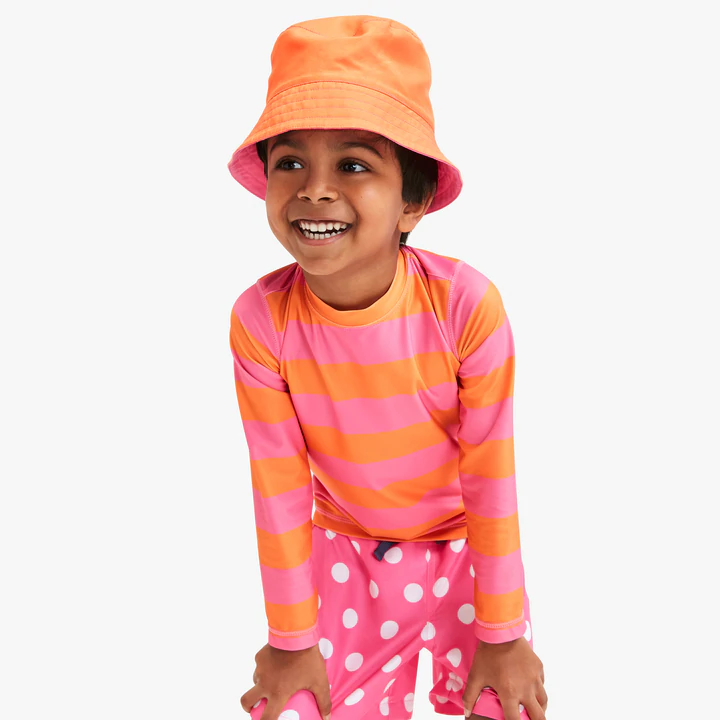
How to Choose the Best Sun Protection Clothes for Kids, According to an Expert
And Why Kids UPF Clothes Should Be in the Mix All Summer Long
It only takes one bad sunburn to convince you that you never want to get sunburned again. It also only takes one bad sunburn to increase the risk of serious health issues later in life, even including the development of skin cancer, according to Healthline. So it turns out your parents were right when they constantly harped on you to reapply sunblock at the beach, to put on a hat at the park, and to get into the shade whenever possible.
What’s that? You’re the parent now? Well, so are we, so we too know the challenges – both emotional and practical – of constantly keeping kids protected against sun damage.
Like we are, you’re surely as good as you can be about applying sunblock to your kids’ exposed skin whenever they’ll be playing outside on sunny days for any extended period of time. But applying sunblock is a pain, especially with younger and/or fussier kids, and it’s all too easy to miss spots even when you do slather the stuff on. A better bet is to physically cover the kids skin with clothing whenever practical given the conditions and activities.
But did you know that even that covered skin, the stuff underneath the t-shirt or jumper, may be at risk for sun damage?
Regular clothing often can’t adequately protect skin from sun damage. To do that, you need to turn to garments rated as having a solid UPF factor. Which is different from SPF, FYI. What constitutes enough UPF protection for kids? What does UPF stand for anyway? Is UPF clothing enough, or is sunblock still needed?
We found ourselves with plenty of questions best answered by an expert instead of by a search engine, so we reached out to an expert. Ryan Lau is the Director of Corporate Social Responsibility, Product Safety, and QA at Primary, a kids clothing company noted for simple, quality garments at fair prices, which is all well and good, but also for being a genuinely decent company in terms of corporate responsibility, sustainability, inclusivity, and that good stuff.
We first asked Ryan a broad question.
What does UPF mean, and how is it incorporated into clothing? And what goes into the science behind the process?
“It isn't like the [SPF rating] of cosmetic or skin care products,” he explained. “In textile industries, we use Ultraviolet Protection Factor, or UPF, to indicate how much UV radiation (both UVB and UVA) that a fabric allows to reach human skin.”
“It is not the Sun Protection Factor (SPF) that is widely used in the health and beauty industries; SPF indicates how much solar energy (UV radiation) is required to produce sunburn on protected skin. The higher the SPF value, the longer the time it takes to get the skin sunburnt. However, the time of getting a sunburn varies from person to person which the SPF value doesn't really take into account.”
So how do you know what counts as a good UPF rating?
“In the US market,” Ryan Lau said, “ASTM* has set up a UV labeling standard for the public to follow. The level of protection is categorized by different UPF performance and 50/50+ is the highest level. [At] 50/50+ less than 2.5% of UV radiation reaches the wearer's skin and the rest of the UV (so some 97.5%) will be absorbed by the textile itself.”
To test UPF garments, Ryan explained that “a piece of textile will be put on a specific testing machine which is able to generate a UVA/UVB beam, the beam is shot onto the fabric, and then a receiver behind the fabric measures how much UV radiation is transmitted.” Which sounds rather intense and we’re sorry for the fabric.
But we’re glad the testing exists, because it has created a way for you to know just how well protected skin is based on the UPF rating of a given sun shirt, sun hat, rash guard, and so on. In fact, Ryan even shared a chart that makes it refreshingly easy to make sense of the numbers:
OK, so we have established that UV protection shirts work but…
How do sun protection clothes work?
The long and short of it all is that when it comes to UPF-protected clothes, it’s all about the weave. According to the Cleveland Clinic, ultraviolet light can penetrate through the minute holes in the weaves of most standard garments or “can even travel directly through a light-colored shirt. With UPF clothing, the block is much greater, giving you more protection from the sun.”
This taut weave is also why sun protection shirts and other UPF garments tend to have a silky smooth feeling – think about sheets with a very high thread count as a comparison. In other words, far from being less comfortable than everyday clothes, UPF garments are often very comfortable.
Do UPF clothes lose their efficacy over time?
To an extent, yes. Contrary to what many people think, the UPF protection does not wash out of a sun protection garment, as it’s not a treatment applied to the textile. Rather, as the apparel ages with wear and washings and sweat and swimming and all, the very fibers inevitably become thinner and more worn. And as we know the tight weave is what makes the sun shirts, rash guards, and other garments work, a worn-down weave means less effective sun protection.
Primary’s Ryan Lau said of the lifespan of UPF clothing: “There is a standard in the US market for this based on ASTM D6544. The UPF performance must stay intact after 40 home launderings plus 100 AFU (or accelerated fading units), which equals approximately 100 hours sunlight exposure or immersing for more than 60 minutes in chlorinated pool water.”
What is the best sun protection clothing for kids?
In the end, the best sun protective clothing is the apparel your kids won’t mind wearing all day long on sunny days. So be it a UPF-protected dress, a quick drying UPF rashguard, a sun hat, or anything else, if your kids are covered with a sun blocking garment with a good UPF rating, that’s a good thing.
Ryan Lau added: “I'd say all the clothing for kids that prolongs safety under the sun are sun protective garments. For sure, swimwear, outdoor athletic clothing, [and more] should always have the highest UPF to protect them.”
*formerly the American Society for Testing and Materials, now ASTM Internationalphotos COURTESY of Primary clothing 








